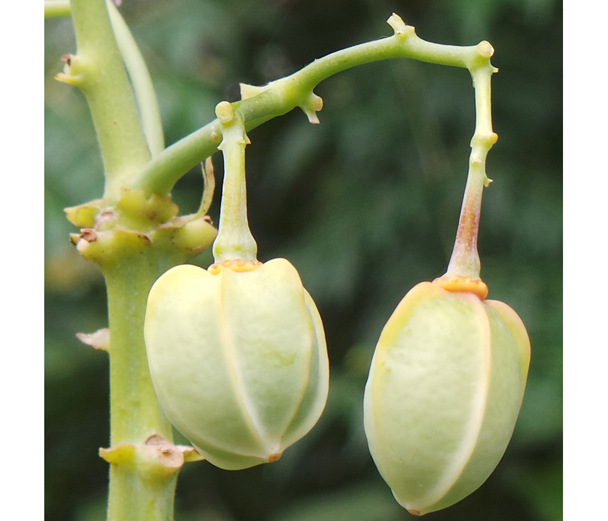

Morphological Characteristics of Bisexual Flowers and Seeds in Cassava
# Co-first authors
Received date: 2016-06-13
Accepted date: 2016-10-16
Online published: 2017-04-05
With the flowering regulation technology of cassava recently developed by our research team, we successfully induced bisexual cassava flowers. These bisexual cassava flowers had the ability for self-pollination bearing fruits. Here, we report the morphological characteristics of bisexual cassava flowers and their capsules and seeds from self-pollination development. Bisexual flowers contain both pistils and stamens, but unisexual flowers contain only one of these. The bisexual flower capsule is ovate and has a large length/width, but the unisexual flower capsule is broadly ovate and has a small length/width. The raphe of bisexual flower seed is not uplifted, but that of unisexual flower seed is uplifted. Bisexual flowers and their seeds are valuable for studying heredity and breeding in cassava, which has important significance for revealing heritable characteristics and cultivating new germplasm in cassava.

Saiqing Lu , Yinong Tian , Lijun Wei , Jun Li , Benchi Yu . Morphological Characteristics of Bisexual Flowers and Seeds in Cassava[J]. Chinese Bulletin of Botany, 2017 , 52(2) : 175 -178 . DOI: 10.11983/CBB16131
| [1] | 陈松笔, 安飞飞, 张振文, 叶剑秋, 欧文军, 肖鑫辉, 李开绵 (2016). 木薯综合育种理论探讨. 生命科学 28, 807-816. |
| [2] | 李开绵, 林雄, 黄洁 (2001). 国内外木薯科研发展概况. 热带农业科学 89, 56-60. |
| [3] | 王明忠, 蒲仕华 (2012). 彩色猕猴桃两性花新品种龙山红的选育. 中国果树 6, 1-3. |
| [4] | 韦本辉, 甘秀芹, 陆柳英, 何虎翼, 唐秀桦, 胡泊, 吴延勇, 宁秀呈, 韦广泼 (2009). 广西木薯诱导开花结实及发芽试验研究初报. 广西农业科学 40, 982-986. |
| [5] | 严华兵, 叶剑秋, 李开绵 (2015). 中国木薯育种研究进展. 中国农学通报 31, 63-70. |
| [6] | 俞奔驰, 罗燕春, 李军, 黄强, 盘欢, 郑华, 文峰, 付海天, 陈显双, 马崇熙, 田益农 (2014). 一种木薯开花调控技术. CN 103733859B. 2015-08-26. |
| [7] | 赵永新 (2016). 我国亚热带木薯杂交育种实现零突破. 农民日报. 2016-04-18. |
| [8] | 邹瑜, 林贵美, 牟海飞, 吕朝安, 吴代东, 张进忠, 覃柳燕, 赵明 (2013). 两性花野生毛葡萄新品种——“野酿2号”的选育. 中国南方果树 42, 107-108. |
| [9] | Alves AAC (2002). Cassava botany and physiology. In: Hillocks RJ, Thresh JM, Bellotti AC, eds. Cassava: Bio- logy, Production and Utilization. New York: CAB International. pp. 67-89. |
| [10] | Ceballos H, Fregene M, Pérez JC, Morante N, Calle F (2007). Cassava genetic improvement. In: Kang MS, Priyadarshan PM, eds. Breeding Major Food Staples. Hoboken: Blackwell Publishing. pp. 365-392. |
| [11] | Rogers DJ, Fleming HS (1973). A monograph ofManihot esculenta with an explanation of the taxonomic methods used. Econ Bot 27, 11-13. |
/
| 〈 |
|
〉 |